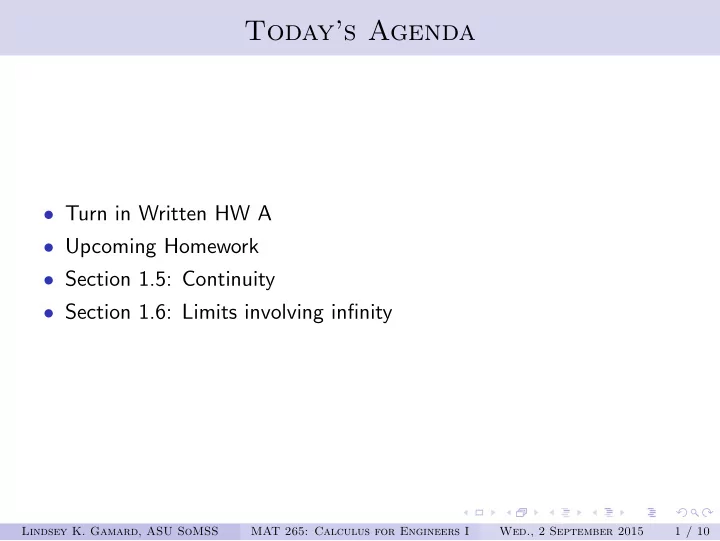

Today’s Agenda • Turn in Written HW A • Upcoming Homework • Section 1.5: Continuity • Section 1.6: Limits involving infinity Lindsey K. Gamard, ASU SoMSS MAT 265: Calculus for Engineers I Wed., 2 September 2015 1 / 10
Upcoming Homework • WeBWorK #4: Section 1.5 due 9/4/2015 • WeBWorK #5: Section 1.6 due 9/9/2015 • Written HW B: Problems TBA, due 9/11/2015 • WeBWorK #6: Sections 2.1 and 2.2, due 9/14/2015 Lindsey K. Gamard, ASU SoMSS MAT 265: Calculus for Engineers I Wed., 2 September 2015 2 / 10
Section 1.5 The Intermediate Value Theorem Suppose that f is continuous on the closed interval [ a , b ] and let N be any number between f ( a ) and f ( b ), where f ( a ) � = f ( b ). Then there exists a number c ∈ ( a , b ) such that f ( c ) = N . The hypotheses of the Intermediate Value Theorem are critical: f must be continuous on the closed interval [ a , b ], otherwise the conclusion of the theorem does not hold! (Can you think of any examples of what goes wrong when the hypotheses are not satisfied? If f is not continuous on all of [ a , b ]? If the interval is open instead of closed?) Lindsey K. Gamard, ASU SoMSS MAT 265: Calculus for Engineers I Wed., 2 September 2015 3 / 10
Section 1.5 An illustration of the Intermediate Value Theorem: Image courtesy: http://tutorial.math.lamar.edu Lindsey K. Gamard, ASU SoMSS MAT 265: Calculus for Engineers I Wed., 2 September 2015 4 / 10
Section 1.5 Example 1.5.1 Suppose f is continuous on [1 , 5] and the only solutions of the equation f ( x ) = 6 are x = 1 and x = 4. If f (2) = 8, explain why f (3) > 6. Example 1.5.2 Use the Intermediate Value Theorem to show that there is a root of the given equation in the specified interval. (a) cos x = x , on (0 , 1) √ x = 1 − x , on (0 , 1) (b) 3 Lindsey K. Gamard, ASU SoMSS MAT 265: Calculus for Engineers I Wed., 2 September 2015 5 / 10
Section 1.6 Definition 1.6.1 The notation x → a f ( x ) = ∞ lim means that the values of f ( x ) can be made arbitrarily large (as large as we please) by taking x sufficiently close to a (on either side of a ) but not equal to a . Definition 1.6.2 The vertical line x = a is called a vertical asymptote of the curve y = f ( x ) if at least one of the following statements is true: lim x → a f ( x ) = ∞ lim x → a + f ( x ) = ∞ lim x → a − f ( x ) = ∞ lim x → a f ( x ) = −∞ lim x → a + f ( x ) = −∞ lim x → a − f ( x ) = −∞ Lindsey K. Gamard, ASU SoMSS MAT 265: Calculus for Engineers I Wed., 2 September 2015 6 / 10
Section 1.6 Definition 1.6.3 Let f be a function defined on some interval ( a , ∞ ). Then x →∞ f ( x ) = L lim means that the values of f ( x ) can be made as close to L as we like by taking x sufficiently large. Definition 1.6.4 The horizontal line y = L is called a horizontal asymptote of the curve y = f ( x ) if either x →∞ f ( x ) = L lim or x →−∞ f ( x ) = L . lim Lindsey K. Gamard, ASU SoMSS MAT 265: Calculus for Engineers I Wed., 2 September 2015 7 / 10
Section 1.6 Comment Some textbooks use stricter definitions than ours does. They require x → a f ( x ) = ∞ lim or x → a f ( x ) = −∞ lim in order to call x = a a vertical asymptote (i.e., it is not enough for the limit to be only one-sided in order to be a vertical asymptote). Similarly, some textbooks require both x →∞ f ( x ) = L lim and x →−∞ f ( x ) = L lim in order for y = L to be called a horizontal asymptote. Lindsey K. Gamard, ASU SoMSS MAT 265: Calculus for Engineers I Wed., 2 September 2015 8 / 10
Section 1.6 Example 1.6.5 In the theory of special relativity, the mass of a particle with velocity v is m 0 m = 1 − v 2 / c 2 , � where m 0 is the mass of the particle at rest and c is the speed of light. What happens as v → c − ? (Why can’t we take the limit as v → c + ?) Lindsey K. Gamard, ASU SoMSS MAT 265: Calculus for Engineers I Wed., 2 September 2015 9 / 10
Section 1.6 Example 1.6.6 A tank contains 5000 L of pure water. Brine that contains 30 g of salt per liter of water is pumped into the tank at a rate of 25 L/min. Show that the concentration of salt t minutes later (in grams per liter) is 30 t C ( t ) = 200 + t . What happens to the concentration as t → ∞ ? Certainly we cannot continue to pump brine into the tank forever. What does this limit mean practically ? Lindsey K. Gamard, ASU SoMSS MAT 265: Calculus for Engineers I Wed., 2 September 2015 10 / 10
Recommend
More recommend